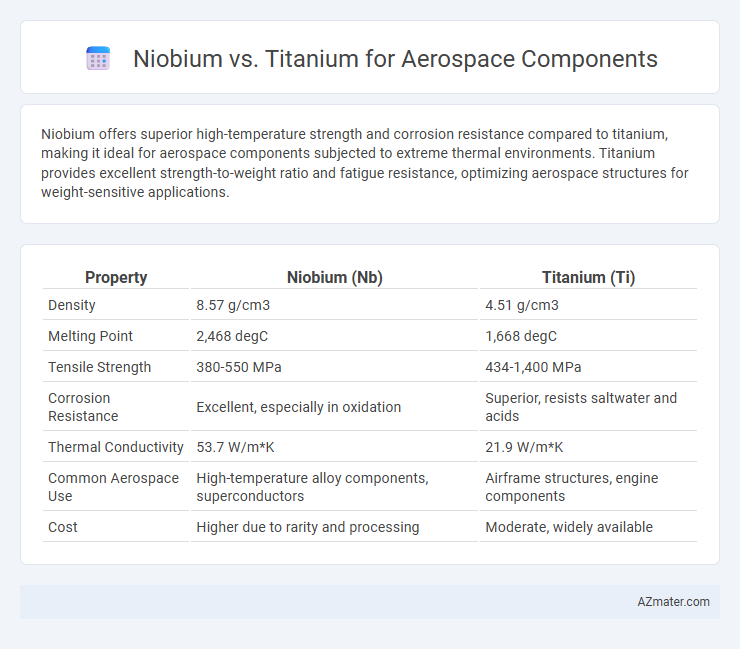Niobium offers superior high-temperature strength and corrosion resistance compared to titanium, making it ideal for aerospace components subjected to extreme thermal environments. Titanium provides excellent strength-to-weight ratio and fatigue resistance, optimizing aerospace structures for weight-sensitive applications.
Table of Comparison
| Property | Niobium (Nb) | Titanium (Ti) |
|---|---|---|
| Density | 8.57 g/cm3 | 4.51 g/cm3 |
| Melting Point | 2,468 degC | 1,668 degC |
| Tensile Strength | 380-550 MPa | 434-1,400 MPa |
| Corrosion Resistance | Excellent, especially in oxidation | Superior, resists saltwater and acids |
| Thermal Conductivity | 53.7 W/m*K | 21.9 W/m*K |
| Common Aerospace Use | High-temperature alloy components, superconductors | Airframe structures, engine components |
| Cost | Higher due to rarity and processing | Moderate, widely available |
Introduction to Niobium and Titanium in Aerospace
Niobium and titanium are critical materials in aerospace engineering due to their high strength-to-weight ratios and excellent corrosion resistance. Niobium's unique superconducting properties and ability to withstand extreme temperatures make it ideal for jet engine components and missile systems. Titanium alloys dominate aerospace structures for their superior strength, low density, and exceptional fatigue resistance, enabling lighter, more durable aircraft frames and engine parts.
Material Properties Overview
Niobium exhibits exceptional high-temperature strength and corrosion resistance, making it ideal for aerospace components exposed to extreme heat and oxidative environments. Titanium offers a high strength-to-weight ratio and excellent fatigue resistance, crucial for structural parts requiring durability and lightweight performance. Both materials provide unique advantages, with niobium excelling in thermal stability and titanium in mechanical resilience and weight reduction.
Strength-to-Weight Ratio Comparison
Niobium and titanium are critical materials in aerospace due to their exceptional strength-to-weight ratios, but titanium typically outperforms niobium with a density of 4.5 g/cm3 compared to niobium's 8.57 g/cm3, offering superior weight savings. Titanium alloys, such as Ti-6Al-4V, exhibit tensile strengths reaching up to 1,100 MPa while maintaining low density, making them ideal for structural components where weight reduction is paramount. Niobium's strength, although substantial, is often leveraged in high-temperature environments or specialized alloys rather than primary load-bearing components where titanium's balance of strength and lightness prevails.
Corrosion and Oxidation Resistance
Niobium exhibits superior corrosion resistance in aggressive oxidizing environments compared to titanium, making it ideal for aerospace components exposed to extreme conditions. Titanium offers excellent oxidation resistance at high temperatures but is more susceptible to localized corrosion like pitting and crevice corrosion. The choice between niobium and titanium hinges on specific environmental factors, with niobium preferred for enhanced chemical stability and titanium favored for weight-sensitive structural parts.
Temperature Performance in Aerospace Applications
Niobium exhibits superior high-temperature strength and oxidation resistance compared to titanium, making it ideal for aerospace components exposed to extreme thermal environments above 1,200degC. Titanium alloys offer excellent strength-to-weight ratios and corrosion resistance but typically degrade in performance at temperatures exceeding 600degC. The selection of niobium over titanium in aerospace often hinges on the specific thermal requirements of engine parts, exhaust systems, and heat shields where sustained high-temperature stability is critical.
Fabrication and Machinability
Niobium exhibits superior high-temperature strength and corrosion resistance, making it ideal for aerospace components subjected to extreme environments, though it requires specialized welding techniques due to its reactivity. Titanium offers excellent strength-to-weight ratio and is easier to machine with conventional tools, but its lower thermal stability compared to niobium limits applications at ultra-high temperatures. Fabrication of niobium demands inert atmospheres to prevent oxidation, whereas titanium's well-established machining protocols enhance production efficiency in aerospace manufacturing.
Cost and Availability of Niobium vs Titanium
Niobium is generally more expensive and less abundant than titanium, making titanium the preferred choice for aerospace components where cost-efficiency and supply reliability are critical. Titanium's widespread availability and lower extraction costs contribute to its dominance in aerospace applications despite niobium's superior high-temperature strength. Cost differentials between the two metals can significantly impact manufacturing budgets, with titanium offering more economically scalable solutions.
Compatibility with Other Aerospace Materials
Niobium exhibits excellent compatibility with aerospace materials such as titanium alloys, nickel-based superalloys, and stainless steels, maintaining structural integrity and resisting oxidation at high temperatures. Titanium's compatibility extends to aluminum, composites, and steel, offering superior corrosion resistance and strength-to-weight ratio in aircraft components. Both metals are critical in aerospace engineering, with niobium often used as an alloying element to enhance titanium and superalloy performance in extreme environments.
Real-World Aerospace Applications
Niobium's superior high-temperature strength and corrosion resistance make it ideal for jet engine components and rocket nozzles, where extreme thermal conditions prevail. Titanium's excellent strength-to-weight ratio and fatigue resistance are critical in airframe structures, landing gear, and rotor blades, optimizing aircraft performance and fuel efficiency. Both metals are essential in aerospace, with niobium enhancing thermal stability and titanium ensuring lightweight durability.
Conclusion: Choosing the Right Alloy
Niobium offers exceptional high-temperature strength and corrosion resistance, making it ideal for aerospace components exposed to extreme environments. Titanium provides an excellent strength-to-weight ratio and superior fatigue resistance, beneficial for structural parts requiring lightness and durability. Selecting the right alloy depends on specific performance demands, thermal conditions, and weight constraints within the aerospace application.

Infographic: Niobium vs Titanium for Aerospace Component
 azmater.com
azmater.com